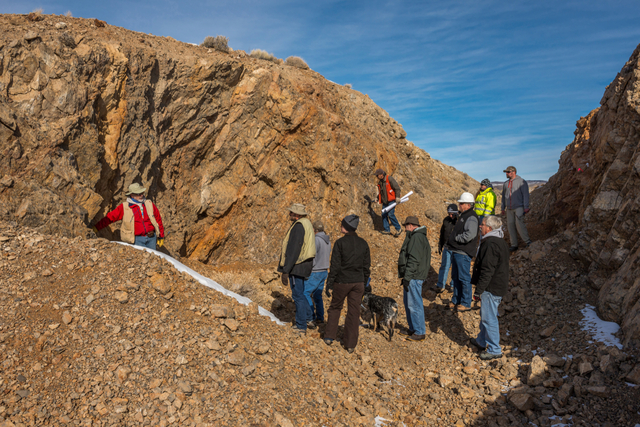Steve Alfers cut his teeth as a transactions lawyer on international mining deals and as a privatization specialist working in some of the world’s most challenging jurisdictions — including Mongolia, Russia, Ukraine, Zambia and Kosovo. But in 2000 he set out on his own to build a gold company.
The first thing he did was team up with a land investor in Nevada, who he prefers not to name, and put together a business plan that involved pulling out the gold assets from the investor’s Nevada holdings, creating a company called “NewWest Gold,” and taking it public on the Toronto Stock Exchange in 2006. NewWest Gold’s package of assets — estimated to be worth US$2.3 billion — included Long Canyon, Sandman and Northumberland.
Alfers served as NewWest Gold’s CEO from 2001 until the company’s merger with Fronteer Gold in September 2007. Newmont Mining (TSX: NMC; NYSE: NEM) went on to pluck NewWest Gold’s assets out of Fronteer and spun off the rest as Pilot Gold (TSX: PLG; US-OTC: PLGTF).
After the merger with Fronteer, Alfers joined Franco-Nevada. (TSX: FNV; NYSE: FNV) as a senior executive, serving as chief of the company’s U.S. operations. But destiny was to intervene again in 2011 — leading him back to the helm of another early stage gold company with an exciting asset on the brink of production.
In August of that year he worked as a consultant to initial investors who had bought a past-producing gold mine called “Relief Canyon” out of bankruptcy proceedings. The investors acquired the asset for all-in costs of US$20 million and Alfers joined their company — subsequently renamed Pershing Gold (US-OTC: PGLC) — as CEO in February 2012.
“When I first looked at Relief Canyon I saw an underdeveloped, under-explored property with opportunity for expansion,” he says. “It is an open-pittable, heap-leachable project with infrastructure already in place. There was potential for land consolidation and I realized that I could put together a team that would fast-track the project back into production. In short, it is the ideal gold project for Nevada today.”
Within a couple of months and several transactions later, Alfers had grown the junior’s property portfolio from 4.5 sq. km to 102 sq. km, and over the course of the next two years expanded the resource at Relief Canyon not once, but twice.
Relief Canyon is a past-producing mine with three open pits and a fully permitted and operation-ready heap-leach facility, 153 km north of Reno in Pershing County. The processing plant — built in 2008 by Firstgold Corp. — produced gold until 2009, and can treat 7.3 million tonnes per year. The leach pad has a 19.1-million-tonne capacity.
Discussions are underway with the Bureau of Land Management to resume mining under the existing plan of operations. Mine expansion above the water table is targeted for next year, while future mine development below the water table will need more permitting.
“We should be in production by mid-2015 and ramped up to full production in 2016,” Alfers says. “We’re a near-term producer.”
Relief Canyon is situated just south of Rochester in Pershing County. It shares a southern boundary with Coeur Mining’s (TSX: CDM; NYSE: CDE) Rochester silver–gold mine, 10 km away, while 24 km northeast lies the Spring Valley project owned by Barrick Gold (TSX: ABX; NYSE: ABX) and Midway Gold (TSX: MDW; NYSE-MKT: MDW), and 14.5 km northwest is Rye Patch Gold’s (TSXV: RPM; US-OTC: RPMGF) past-producing Willard mine.
“We’ve got a good address,” Alfers notes. “Rochester is in a big system and, although Relief Canyon is a different kind of deposit, I feel like we’re in the heart of that system.”
In 2013 the company expanded the 155,000 oz. gold resource (from June 2010) to a global resource of 564,000 oz. gold, and earlier this year grew it yet again, this time to 717,000 oz. gold.
Measured and indicated resources stand at 25.1 million tonnes grading 0.685 gram gold per tonne for 552,000 contained oz. gold, with inferred resources of 9.4 million tonnes averaging 0.548 gram gold for 165,000 contained oz. gold.)
This year the company plans to spend $1.5 million on exploration at Relief Canyon, with a 9,000-metre drill program. Some drilling will target the high wall of the open pit to expand the resource to the east, plus stepout holes to test for high-grade mineralization within and north of the open pit. Infill holes will also be drilled to expand high-grade zones within the pit’s Lower and Jasperoid zones.
“It is estimated that less than 10% of the entire [102 sq. km] area has been explored to date, and only 50–60% of the deposit has been explored as well, leaving plenty of potential for blue-sky resource expansion,” Rob Chang, an analyst at Cantor Fitzgerald, writes in a report.
Drill holes from 2013 include several high-grade intercepts, such as 6.44 grams gold per tonne over 6.3 metres, 7.68 grams gold over 13.3 metres and 5.486 grams gold over 1.6 metres.
Chang estimates initial production of 85,000 oz. per year in 2016, ramping up to just over 100,000 oz. per year in the next three years. The analyst anticipates cash costs of under US$800 per oz. over the current mine life and all-in sustaining costs just above US$800 per oz.
“We expect production to only come from above the water table for the first two years and go below the water table in 2018, where there is higher grade and higher costs due to depth and the associated higher strip ratio,” Chang adds.
Relief Canyon produced 131,000 oz. gold and 111,000 oz. silver when it was mined in the 1980s.


Be the first to comment on "Relief Canyon grows under Pershing"